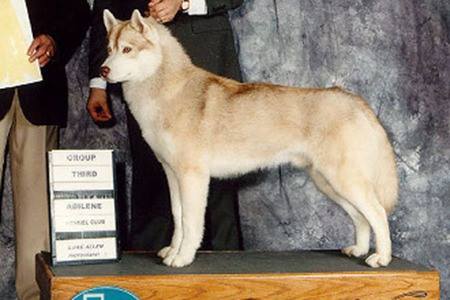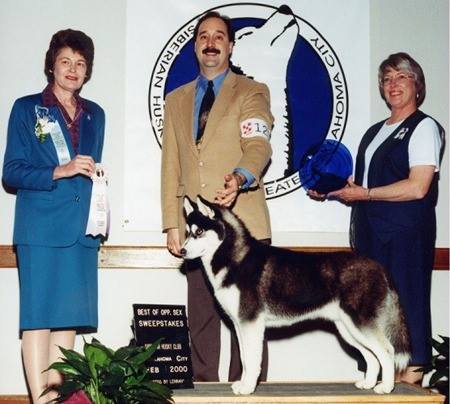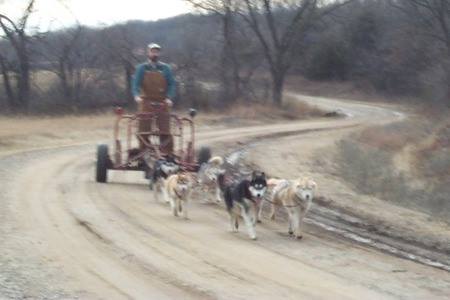COVER ~ CONTENTS ~ ARCHIVES ~ CREDITS ~ LINKS ~ BACK COVER ~ CONTACT US
I admit that I have only spent 9 years living with and studying Italian Greyhounds and have much to learn, yet having learned so much about movement from Siberian Huskies, I have a concern that Italian Greyhounds can face a similar issue that affects their movement as a true hound. As a Toy, and not in the Working or Hound group, maybe expectations about movement are lessened. If an Italian Greyhound does not move out no one’s life is on the line. Still soundness in movement is something that is deeply desired. Rather than being fascinated with extending side gate that flattens the croup, I think that sometimes I. G. breeders are sacrificing sound movement to achieve excessive rear curviness. The problem looks to be the opposite of what I was seeing in Siberian Huskies. With Italian Greyhounds it looks like dogs who have no rear drive because of a steep croup that keeps the rear movement under the dog with no rear extension, moving in a box and going nowhere. Lilian Barber has warned us of this when she writes, “Dogs with excessive topline are very likely to have little or no drive in the rear, especially when the topline drops off steeply, causing the hind legs and quarters to be tucked under when the dog is in a normal standing position. Such a specimen has a difficult time getting out of its own way.” (Lilian Barber, The Italian Greyhound, 21st Century, 2002, p. 155) I think there is much we can learn about our wonderful Italian Greyhounds by looking outside the breed to other performance dogs. The one thing that seems sure to me from my experience with dogs is that at every step, I learn how much more there is to know. It also has given me a deep appreciation of the wide variety and breadth, there is in the world of dogs and yet how basic our love of them is.
Rev's Reflections

By Scott & Floyd
We came to showing Italian Greyhounds, in an unusual way. In the 1990’s and early 2000’s we were showing and sledding with Siberian Huskies, but as our kids entered junior high (with all the attached busyness) and we were struggling with our dogs producing juvenile cataracts, we stepped out of showing and breeding. Angie and I had been attracted to the Whippets at the shows and then to the Italian Greyhounds. So as the number of Siberian Huskies at our house reduced the family wanted a house dog and Angie suggested an Italian Greyhound. I liked the idea because while they were small they were also athletic and so we began looking for our first Italian Greyhound.
Having shown before, I want a dog from an established show kennel. We were living in Atlanta and the first few kennels we reached out to, were not helpful because we had not had Italian Greyhounds before. We soon found Dr. Lois March of Marchwind Italian Greyhounds. We weren’t looking to show at the time, but she had a nice young dog out of her top producer Ch. Marchwind Charlie The Kidd who became our first I.G., Marchwind Pepper Jack. Jack was so different from our Siberian Huskies but he loved to dig into their run and play with them and they all loved to run. Watching them (and later our other I.G.s) run together I began to see that even though they are very different, there were lessons to learn from each other.
“Champion Kossok's Oklahoma Sunrise”

Coming from a breed where movement was a matter of life and death (imagine the risk of dogs leaving you stranded in Alaska’s winter) one learns to develop an eye for sound movement. The Official Standard of the Siberian Husky describes the function of the breed as, “carrying a light load at a moderate speed over great distances. His body proportions and form reflect this basic balance of power, speed and endurance.” Balance is key because excesses in any area leads to a dog that breaks down in the harness. The Siberian Husky naturally has a nice extending side gate but as can sometimes be the case, the show ring began rewarding the dogs whose side gate seems to beautifully extend farther forward and farther back. The problem was it often came at the loss of basic balance and ability to drive in the rear. I remember one particular special whose rear extension wowed everyone but it was gained by flattening the croup and giving up the ability for the rear to reach under the dog and drive it forward. Instead, all its movement was in the air behind the dog. My first show Siberian Husky, Okie, had a beautiful extending side gate but he was not as right as a later dog I showed, Sky, for this very reason.

“Champion Kossok’s Big Sky Over Skidi”

“When sled dogs have no snow”
“From Siberian to Italy”